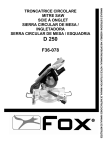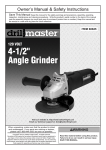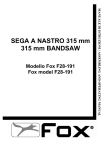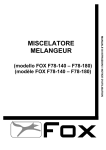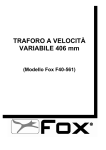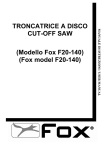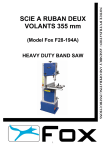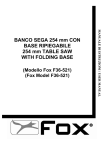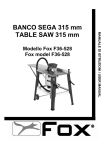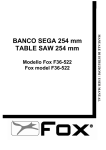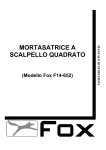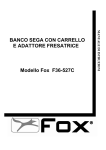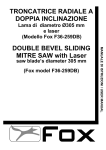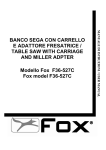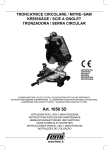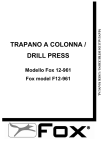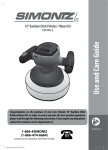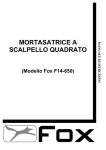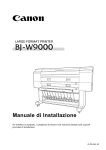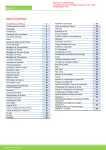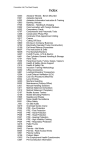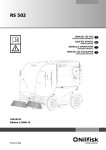Download manuale d`uso f36-075
Transcript
Modello Fox F36-075 Fox model F36-075 MANUALE DI ISTRUZIONI / ASSEMBLING AND OPERATING MANUAL TRONCATRICE CIRCOLARE MITRE SAW D 210 SOMMARIO / INDEX ITALIANO (IT) Manuale originale, Original manual ENGLISH (EN) Manual translated from the original, Manuale tradotto dall’originale 3÷24 25÷46 DICHIARAZIONE DI CONFORMITA / DECLARATION OF CONFORMITY 47 ESPLOSO / EXPLODED VIEW 48 SCHEMA ELETTRICO / WIRING DIAGRAM 50 2 SOMMARIO • • • • • • • • • • • • • • • • • • • Sicurezza Regole generali di sicurezza Regole supplementari di sicurezza per le troncatrici Norme di sicurezza per i rischi residui Protezione dell’ambiente Simboli Collegamento dell’utensile alla corrente Descrizione della macchina Caratteristiche tecniche Informazioni sul rumore Disimballo Descrizione dei componenti della macchina Regolazioni - Regolazione dell’ angolo di taglio rotazione testa - Regolazione dell’ angolo di taglio inclinazione testa - Regolazione altezza piano superiore - Regolazione della squadra di appoggio - Montaggio prolunghe piedi base - Montaggio delle estensioni del piano - Montaggio della morsa orizzontale - Regolazione degli angoli di taglio - Fissaggio della segatrice ad una superficie - Spostamento della segatrice Utilizzazione - Uso come troncatrice - Uso come sega circolare - Montaggio e/o sostituzione della lama Scelta della lama Aspirazione delle polveri Manutenzione - Ispezione e sostituzione delle spazzole Guida alla localizzazione dei guasti Assistenza 3 Pag. 4 Pag. 5 Pag. 7 Pag. 8 Pag. 9 Pag. 9 Pag. 10 Pag. 11 Pag. 12 Pag. 12 Pag. 13 Pag. 13 Pag. 14 Pag. 14 Pag. 14 Pag. 15 Pag. 16 Pag. 16 Pag. 16 Pag. 16 Pag. 17 Pag. 17 Pag. 18 Pag. 18 Pag. 18 Pag. 19 Pag. 20 Pag. 21 Pag. 21 Pag. 22 Pag. 22 Pag. 23 Pag. 24 SICUREZZA ATTENZIONE: Quando si utilizzano utensili elettrici si dovrebbero sempre rispettare, oltre a quelle riportate in questo manuale, tutte le precauzioni base di sicurezza per ridurre il rischio di incendio, scossa elettrica e danni personali. Leggere attentamente tutte queste istruzioni prima di utilizzare questo prodotto e conservarle scrupolosamente. Le lavorazioni effettuate con un elettroutensile possono diventare pericolose per l’operatore se non vengono rispettate norme operative sicure ed adeguate. Come per qualsiasi macchina elettrica che ha un organo di lavoro in movimento, l’utilizzo dell’utensile comporta alcuni rischi. Se la macchina viene utilizzata come indicato su questo manuale, prestando la massima attenzione al lavoro che si sta facendo, rispettando le regole ed utilizzando gli adeguati dispositivi di protezione individuali, la probabilità di incidenti sarà quasi nulla. Le attrezzature di sicurezza previste sulle macchine, come le protezioni, i carter, gli spingipezzo, i dispositivi di ritenuta, i dispositivi di protezione individuale come gli occhiali, le maschere antipolvere, le protezioni auricolari, le scarpe e i guanti possono ridurre le probabilità di incidente. Anche la migliore protezione, però, non può proteggere contro la mancanza di buon senso e di attenzione. Abbiate sempre buon senso e prendete le precauzioni necessarie. Fate solo i lavori che ritenete siano sicuri. NON DIMENTICATE: la sicurezza è responsabilità di ognuno. Questo utensile è stato concepito per un utilizzo ben preciso. DELTA France raccomanda di non modificarlo o di non utilizzarlo per scopi diversi rispetto a quelli per cui è stato costruito. Se avete dei dubbi relativamente ad applicazioni specifiche, NON utilizzate l’utensile prima di aver contattato DELTA France e aver ricevuto informazioni in merito. LEGGETE E CONSERVATE QUESTO MANUALE 4 REGOLE GENERALI DI SICUREZZA 1. Mantenete l’area di lavoro pulita. Nelle zone o nei banchi di lavoro ingombri è più alta la probabilità di incidenti. 2. Evitate un ambiente pericoloso. Non esponete gli utensili alla pioggia e non utilizzateli in ambienti umidi o bagnati, per evitare i fenomeni di elettrolocuzione. Mantenete la zona di lavoro ben illuminata. Non utilizzate l’utensile in presenza di gas o di liquidi infiammabili. 3. Collegate il dispositivo di aspirazione della polvere. Se sono previsti dei metodi per il recupero della polvere, assicuratevi che questi dispositivi siano collegati e utilizzati correttamente. 4. Tenete gli estranei e i bambini lontani. Tutti gli estranei e i bambini devono mantenere una distanza di sicurezza dall’area di lavoro. 5. Proteggetevi dalle scariche elettriche. Evitate di entrare in contatto con delle superfici di messa a terra. 6. Non maltrattate il cavo elettrico. Non tirate mai il filo elettrico per scollegarlo dalla presa. Mantenete il cavo elettrico lontano dal calore, dall’olio e dagli spigoli vivi. 7. Utilizzate delle prolunghe elettriche previste per l’esterno. Quando l’utensile viene utilizzato all’esterno, utilizzate solamente delle prolunghe elettriche previste per l’esterno e che riportino delle indicazioni in merito. 8. Siate vigili. Osservate attentamente quello che fate, abbiate buon senso. Non utilizzate l’utensile quando siete affaticati. 9. Non utilizzate l’utensile se siete sotto l’effetto di medicinali, alcol, droghe. 10. Evitate l’avvio accidentale. Assicuratevi che l’interruttore sia nella posizione di arresto prima di collegare l’utensile. 11. Indossate una tenuta appropriata. Non indossate vestiti ampi o gioielli che possono impigliarsi nei pezzi mobili. Per il lavoro all’esterno sono particolarmente raccomandate le scarpe antiscivolo. Portate un mezzo di protezione per i capelli lunghi. 12. Usate sempre i dispositivi di protezione personale: portate gli occhiali di sicurezza e mascherine nei casi in cui si producano polveri o trucioli. Indossate cuffie antirumore o tappi protettivi in ambienti rumorosi. Usate guanti quando si maneggiano particolari con spigoli vivi e taglienti. 13. Non sbilanciatevi sopra all’utensile. Mantenete sempre il vostro equilibrio. 14. Chiedete consigli a persone esperte e competenti se non avete familiarità con il funzionamento dell’utensile. 15. Allontanate gli utensili inutilizzati. Quando gli utensili non vengono utilizzati, devono essere sistemati in un luogo secco, chiuso a chiave, fuori dalla portata dei bambini. 5 16. Non forzate l’utensile. La lavorazione sarà migliore e maggiormente sicura se l’utensile viene utilizzato al ritmo per il quale è stato concepito. 17. Utilizzate l’utensile appropriato. Non forzate un piccolo utensile a fare il lavoro di un utensile a utilizzo intensivo. Per esempio, non utilizzate una sega circolare per tagliare dei rami o dei ceppi. 18. Fissate il pezzo. Utilizzate per quanto possibile dei morsetti a vite o una morsa per bloccare il pezzo. E’ più sicuro che servirsi delle sole mani. 19. Mantenete gli utensili in perfetto stato. Tenete gli utensili affilati e puliti in modo da ottenere un rendimento migliore e più sicuro. Seguite le istruzioni per lubrificare e sostituire gli accessori. Controllate regolarmente il cavo elettrico e sostituitelo se è danneggiato. Tenete le maniglie e le impugnature secche, pulite e prive di olio e di grasso. 20. Scollegate l’utensile dalla rete quando non è utilizzato, prima della manutenzione e della sostituzione degli accessori o utensili quali lame, punte, frese, ecc. 21. Allontanate le chiavi di serraggio e di regolazione. Prendete l’abitudine di verificare che le chiavi di serraggio e di regolazione siano state allontanate dall’utensile prima di avviarlo. 22. Controllate i particolari dell’utensile per verificare che non ci siano parti danneggiate. Prima di continuare ad utilizzare l’utensile, controllate tutti i dispositivi di sicurezza o qualsiasi altro pezzo che possa essere danneggiato in modo da assicurarvi che funzioni bene e che riesca ad effettuare il compito previsto. Verificate che i pezzi mobili siano ben allineati, non si blocchino e non siano rotti. Controllate anche il montaggio o qualsiasi altra condizione che può influenzare il funzionamento. Qualsiasi pezzo o qualsiasi protezione danneggiata deve essere riparata o sostituita da un centro di servizio postvendita autorizzato. Non utilizzate l’utensile se l’interruttore non funziona correttamente. 23. Utilizzate l’elettroutensile, gli utensili e gli accessori nel modo e per gli scopi riportati in questo manuale; utilizzi e componenti diversi possono generare possibili rischi per l’operatore. 24. Fate riparare l’utensile da una persona competente. Questo utensile elettrico è conforme alle prescrizioni di sicurezza corrispondenti. Le riparazioni devono essere realizzate solo da persone qualificate che utilizzino ricambi originali, altrimenti potrebbero insorgere dei pericoli per l’utilizzatore. 6 REGOLE SUPPLEMENTARI DI SICUREZZA PER LE TRONCATRICI 1. Non usare la troncatrice se le protezioni non sono in posizione, specialmente dopo aver effettuato il cambio di modo; assicurarsi che sia in perfetta efficienza e che venga fatta la regolare manutenzione. 2. Sostituire l’inserto del piano quando è usurato. 3. Non usare lame danneggiate. 4. Utilizzare solo lame consigliate dal costruttore, ben affilate, conformi alla norma EN847-1 e adatte al materiale da tagliare; prima di sostituire una lama verificare che il diametro esterno e quello del foro siano coerenti con quelli da utilizzare sulla sega, che lo spessore del cuneo sia inferiore alla larghezza del taglio fatto dalla lama e superiore allo spessore del corpo della lama e che la velocità marcata sulla lama sia superiore alla velocità della macchina indicata sulla targhetta dati. 5. Non utilizzare lame in acciaio rapido, marcate con la sigla “HS“; usate lame con inserti in metallo duro marcate con la sigla “HW“. 6. Accertarsi che il braccio sia ben fissato nel taglio composto. 7. Collegare la troncatrice ad un sistema di aspirazione della polvere durante il taglio. 8. Usare sempre i dispositivi di protezione appropriati: mascherine antipolvere per la protezione delle vie respiratorie, protezioni per l’udito, occhiali protettivi, guanti quando si manipolano le lame o materiali che presentano bave; le lame vanno sempre spostate e manipolate fino al luogo di utilizzo all’interno della loro custodia. 9. Riporre sempre l’asta spingipezzo (spintore) quando non viene utilizzata. 10. Segnalare le avarie che avvengono nella troncatrice, comprese quelle delle protezioni e delle lame, non appena vengono individuate. 11. Non usare la troncatrice per tagliare materiali non previsti dal produttore. 12. info su sollevamento e trasporto e info di non usare le protezioni come mezzi di presa. 13. Assicurarsi che il pavimento attorno alla macchina sia tenuto libero da materiali sciolti come trucioli, segatura e pezzi tagliati. 14. Si consiglia l’uso della troncatrice in un luogo dotato di una illuminazione adeguata. 15. Info per sostituzione lama con raccomandazioni per il riposizionamento della protezione e le istruzioni su come farlo come troncatrice o sega da banco. 16. Info sull’uso dello spingipezzo (spintore) nell’uso come sega da banco per non avvicinare troppo le mani alla lama. 17. L’operatore deve essere adeguatamente istruito sull’uso della troncatrice, sulle regolazioni e sulla manutenzione. 18. Nel taglio come sega da banco accertarsi che il braccio sia fissato nella posizione di lavoro. 19. Fermare la sega quando viene lasciata incustodita. 20. Assicurarsi che il piano di lavoro sia ben fissato alla giusta altezza. 21. Nell’utilizzo come troncatrice assicurarsi che la parte superiore della sega sia completamente coperta. 22. Assicurarsi che la macchina sia, quando possibile, ben fissata al banco di lavoro. 23. Evitare di togliere i pezzi tagliati e gli sfridi con la lama in movimento e il braccio non in posizione di riposo. 24. I pezzi di legno lunghi, che sporgono dal piano di lavoro della macchina, devono essere adeguatamente sostenuti con cavalletti o mezzi analoghi, per evitare che possano cadere. 25. Il cuneo deve essere sempre correttamente posizionato rispetto ai denti delle lame che si possono montare: deve sempre essere ad una distanza tre 3 e 8 mm dai denti e ad una distanza mai inferiore a 5 mm dalla sommità del dente più alto. 26. Durante il trasporto la parte superiore della lama deve essere coperta. 27. Nella lavorazione come sega da banco deve sempre essere montata la protezione inferiore supplementare. 28. Quando la lama rimane inceppata nel pezzo da lavorare, spegnere sempre la macchina prima di rimuovere il pezzo. 7 NORME DI SICUREZZA PER I RISCHI RESIDUI Non forzate inutilmente la macchina: una pressione di taglio eccessiva può provocare un rapido deterioramento della lama ed un peggioramento delle prestazioni della macchina in termini di finitura e di precisione di taglio. - Nel taglio dell’alluminio e materie plastiche usate sempre gli appositi morsetti: i pezzi oggetto di taglio devono sempre essere tenuti fermamente nella morsa. - Evitate partenze accidentali: non tenete premuto il pulsante di marcia mentre inserite la spina nella presa di corrente. - Usate gli utensili raccomandati in questo manuale, se volete ottenere dalla vostra troncatrice le migliori prestazioni. - Tenete sempre le mani lontane dalle zone di lavorazione mentre la macchina è in movimento; prima di eseguire qualsiasi operazione rilasciate il pulsante nell’impugnatura, spegnendo la macchina e facendola fermare. - Verificare il completo inserimento del perno di blocco n° 16 (fig. 3) nell’utilizzo come sega circolare. Le lavorazioni effettuate con un elettroutensile possono diventare pericolose per l’operatore se non vengono rispettate norme operative sicure ed adeguate. Come per qualsiasi macchina elettrica che ha un organo di lavoro in movimento, l’utilizzo dell’utensile comporta alcuni rischi. Se la macchina viene utilizzata come indicato su questo manuale, rispettando le regole ed utilizzando gli adeguati dispositivi di protezione individuali, la probabilità di incidenti sarà quasi nulla. I possibili rischi residui sono relativi a : 1 – contatti diretti od indiretti con la scossa elettrica 2 – ferimenti per contatto con parti rotanti in movimento e in particolare i denti della sega 3 – ferimenti per contatto con parti spigolose o taglienti quando si cambia la lama 4 – ferimenti per eiezioni di parti di utensile o di materiale in lavorazione 5 – danni all’udito causati dal rumore nell’operazione di taglio 6 - danni causati dalla inalazione delle polveri pericolose prodotte 8 PROTEZIONE DELL’AMBIENTE INFORMAZIONE AGLI UTENTI Ai sensi dell’art. 13 del Decreto Legislativo 25 luglio 2005, n. 151 “Attuazione delle Direttive 2002/95/CE, 2002/96/CE, e 2003/108/CE, relative alla riduzione dell’uso di sostanze pericolose nelle apparecchiature elettriche ed elettroniche, nonché allo smaltimento dei rifiuti”, si precisa quanto segue: • Il simbolo del cassonetto barrato riportato sull’apparecchiatura o sulla confezione indica che il prodotto alla fine della propria vita utile deve essere raccolto separatamente dagli altri rifiuti. • L’utente dovrà, pertanto, conferire l’apparecchiatura giunta a fine vita agli idonei centri di raccolta differenziata dei rifiuti elettronici ed elettrotecnici, oppure riconsegnarla al rivenditore al momento dell’acquisto di una nuova apparecchiatura di tipo equivalente, in ragione di uno ad uno. • L’adeguata raccolta differenziata per l’avvio successivo dell’apparecchiatura dismessa al riciclaggio, al trattamento ed allo smaltimento ambientalmente compatibile, contribuisce ad evitare possibili effetti negativi sull’ambiente e sulla salute e favorisce il reimpiego e/o riciclo dei materiali di cui è composta l’apparecchiatura. ATTENZIONE! Lo smaltimento abusivo del prodotto da parte dell’utente comporta l’applicazione delle sanzioni amministrative previste dalla normativa vigente. SIMBOLI Indossate sempre degli occhiali di protezione per evitare schizzi durante l’utilizzo della macchina. Leggete e comprendete il manuale di istruzioni prima di utilizzare la macchina. Portare sempre una maschera di protezione se l’operazione produce della polvere. Indossate sempre un casco che vi protegga dal rumore durante l’utilizzo della macchina. 9 Prodotto conforme alle norme relative della CE. Doppio isolamento. Questo simbolo significa che nessun elemento che può condurre la corrente è accessibile senza l’utilizzo di un utensile. Questi apparecchi sono privi di conduttore di terra. Matricola/anno costruzione Divieto accesso, zona pericolosa COLLEGAMENTO DELL’UTENSILE ALLA CORRENTE ALLACCIAMENTO ELETTRICO Per l’alimentazione della vostra macchina è necessaria una tensione alternata a 230 V 50 Hz. Assicuratevi che la vostra alimentazione abbia queste caratteristiche, che sia protetta da un interruttore differenziale e magnetotermico. Se la vostra macchina non funziona quando è collegata ad una presa, verificate attentamente le caratteristiche dell’alimentazione. PROLUNGHE ELETTRICHE Utilizzate solamente delle prolunghe elettriche a tre conduttori con una spina a due spinotti e contatto di terra e delle prese a due cavità e una terra corrispondente alla spina dell’utensile Quando utilizzate un utensile elettrico ad una distanza considerevole dall’alimentazione, assicuratevi di utilizzare una prolunga di dimensioni sufficienti per trasportare la corrente di cui l’utensile ha bisogno. Una prolunga sotto dimensionata provocherebbe una caduta di tensione elevata nella linea, con perdita di potenza e conseguente surriscaldamento del motore. Possono essere utilizzate solamente delle prolunghe conformi alle norme CE . Lunghezza della prolunga elettrica: fino a 15 m Dimensioni del cavo: 3 x 2,5 mm² Prima di utilizzare qualsiasi prolunga, verificate che non abbia dei fili scoperti e che l’isolante non sia tagliato o usurato. Riparate o sostituite immediatamente la prolunga danneggiata o usurata. ATTENZIONE: Le prolunghe devono essere sistemate fuori dalla zona di lavoro per evitare che possano entrare in contatto con i pezzi in lavoro, l’utensile o altri particolari della macchina e creare possibili rischi. 10 ATTENZIONE: TENETE GLI UTENSILI E LE ATTREZZATURE FUORI DALLA PORTATA DEI BAMBINI. ATTENZIONE: L’ impianto elettrico della vostra segatrice è dotato di relè di minima tensione, che apre automaticamente il circuito quando la tensione scende sotto un minimo prestabilito, e che impedisce il ripristino automatico della condizione di funzionamento quando la tensione ritorna ai livelli nominali previsti. Se la macchina subisce un arresto involontario non allarmatevi, ma controllate se effettivamente sia venuta a mancare la tensione nell’ impianto di rete. DESCRIZIONE DELLA MACCHINA (Fig. 1) La troncatrice circolare è composta da tre parti fondamentali: il corpo centrale , comprendente il motore 6, che è collegato alla base 3 tramite lo snodo 4 ed il supporto girevole 5, ed il gruppo di lavoro superiore, comprendente il piano di lavoro 12, la squadra di appoggio 14 e la protezione mobile della lama 13. La base 3 viene impiegata come appoggio quando si devono eseguire operazioni di troncatura ed intestatura nelle diverse angolazioni disponibili; il piano superiore viene impiegato come appoggio quando si devono rifilare o sezionare tavole di legno di grandi dimensioni, ed in particolare nel taglio del legno lungo vena. 13 14 12 6 4 5 Fig.1 3 USO CONSENTITO Essa puó tagliare: - LEGNO DURO E TENERO, NAZIONALE ED ESOTICO, LUNGO E TRAVERSO VENA e con adeguati adattamenti (lama specifica e morsetti solo in modalità troncatrice): - MATERIE PLASTICHE - ALLUMINIO E SUE LEGHE 11 USO NON CONSENTITO Non è adatta per il taglio di: - MATERIALI FERROSI, ACCIAI E GHISE E DI QUALSIASI ALTRO MATERIALE DIVERSO DA QUELLI SPECIFICATI NELL’USO CONSENTITO, ED IN PARTICOLARE DI SOSTANZE ALIMENTARI. - SEGA CIRCOLARE SENZA PROTEZIONE LAMA. CARATTERISTICHE TECNICHE Potenza motore: Tensione di alimentazione e frequenza: Velocità: Dimensioni MAX della lama: Taglio trasversale a 90°: Taglio obliquo 45°: Taglio inclinato a 45°: Taglio composto: Arresti di taglio destra e sinistra: Arresti di inclinazione: Peso netto: Peso lordo: Vibrazione mano-braccio: 1200 W S1 230 V - 50 Hz 4500 giri/min. 210 x 30 x 2.5 mm (24 denti) 57 x 120 mm 55 x 70 mm 43 x 120 mm 23 x 40 mm 0° - 45° ogni 5° 0 e 45° 12 kg 13 kg < 2,5 m/sec2 INFORMAZIONI SUL RUMORE Il rumore emesso, misurato conformemente alle norme EN61029, EN3744 e EN11201 è risultato essere: - Livello di pressione acustica LpA = 99 dB(A) - Livello di potenza sonora LWA = 112 dB(A) - Incertezza della misura K = 3 dB Si consiglia di indossare adeguati protettori acustici. Le sorgenti del rumore della sega sono: il motore elettrico e la sua ventilazione, il riduttore di velocità, la lama e ovviamente il materiale da tagliare. Per il motore e la sua ventilazione si consiglia di tenerlo controllato e puliti i passaggi dell’aspirazione, per le lame di utilizzare tipi silenziati, di tenerle sempre in perfetta efficienza e per il materiale da tagliare di usare le lame giuste e di tenere sempre ben bloccati i particolari da tagliare. I valori indicati per il rumore sono livelli di emissione e non necessariamente livelli di lavoro sicuro. Mentre vi è una correlazione tra livelli di emissione e livelli di esposizione, questa non può essere usata affidabilmente per determinare se siano richieste o no ulteriori precauzioni. I fattori che influenzano il reale livello di esposizione del lavoratore includono la durata dell’esposizione, le caratteristiche dell’ambiente, altre sorgenti di rumore, per esempio il numero di macchine e altre lavorazioni adiacenti. Inoltre i livelli di esposizione possono variare da un Paese a Paese. Queste informazioni mettono comunque in grado l’utilizzatore della macchina di fare la miglior valutazione dei pericoli e dei rischi. 12 DISIMBALLO (Fig. 2) Nell’imballo della sega sono presenti: 1 – Troncatrice 2 – Chiavi per la sostituzione lama 3 – Chiave a brugola 5 mm 4 – Estensioni piano (n°2) 5 – Morsa orizzontale 6 – Protezione supplementare inferiore 7 – Spintore 8 – Goniometro integrale al regolo 9 – Pomello bloccaggio girevole 10 – Prolunghe piedi base Fig. 2 Togliere la troncatrice e tutti i vari componenti dall’imballo, verificare che non manchi nulla e che non ci sia niente di danneggiato. Nel caso fossero presenti parti difettose o rovinate non utilizzarla per non compromettere l’efficienza e la sicurezza dell’utensile. Rivolgersi ad un centro assistenza autorizzato per la sostituzione dei particolari difettosi. Per rendere perfettamente funzionante la troncatrice devono essere montati vari particolari, per i quali viene data una dettagliata spiegazione nel seguito. DESCRIZIONE DEI COMPONENTI DELLA MACCHINA (Fig. 3) 1 2 3 4 5 6 7 8 9 10 11 12 13 14 15 16 17 18 19 20 27 Impugnatura di comando Interruttore di marcia Base Snodo corpo/base Supporto girevole Motore Lama Pomello bloccaggio girevole Pulsante di sblocco discesa corpo Protezione mobile lama Protezione mobile lama Piano di lavoro superiore Protezione mobile superiore Squadra di appoggio Piedi di appoggio Perno di blocco Indice Appoggio angolare Pulsante blocco interruttore Estensioni piano lavoro Morsa orizzontale 14 13 9 12 1 2 7 19 6 10-11 16 27 4 20 15 17 Fig. 3 13 5 8 3 18 REGOLAZIONI ATTENZIONE! Prima di effettuare qualsiasi operazione di regolazione, manutenzione, pulizia, cambio lama sulla sega assicuratevi che questa sia spenta e scollegata da qualsiasi fonte di corrente. Quando tutte le regolazioni sono state effettuate, assicuratevi che tutte le chiavi e gli utensili siano lontani dalla macchina, e che tutte le viti, i bulloni e gli altri dispositivi di fissaggio siano bloccati correttamente. Non utilizzate la segatrice prima di aver effettuato queste procedure. Mentre effettuate queste regolazioni, controllate che tutti i particolari della sega funzionino correttamente e siano in buono stato. Qualsiasi danno o pezzo rotto deve essere sostituito da una persona qualificata prima dell’utilizzo. REGOLAZIONE DELL’ ANGOLO DI TAGLIO-ROTAZIONE TESTA (Fig. 3) La troncatrice è in grado di effettuare tagli orientati sia verso destra che verso sinistra. Le posizioni fisse già tarate sono ogni 5° di spostamento sia a destra che sinistra. Per ottenere queste posizioni, allentate il pomolo 8, sbloccate la testa della macchina e fate ruotare il supporto girevole tramite l’impugnatura 1 e bloccate il supporto girevole tramite il pomolo 8. La testa si arresterà automaticamente quando di volta in volta l’indice 17 si troverà allineato alla corrispondente posizione scelta sulla targa graduata. Per tutte le posizioni intermedie, una volta allineato l’indice 17 con la posizione sulla targa, bloccate il supporto girevole tramite il pomolo 8. REGOLAZIONE DELL’ ANGOLO DI TAGLIO-INCLINAZIONE TESTA (FIG. 4) La testa della macchina può inclinarsi fino ad un massimo di 45° verso sinistra. Alzate il piano superiore fino alla sua massima altezza, sbloccate la manopola 21 nella parte posteriore della macchina, ed inclinate la testa fino all’arresto sul fermo a 45°. Bloccate la manopola 21 ATTENZIONE: Verificare che la manopola 21 garantisca in ogni fase di lavoro il bloccaggio della testa in qualsiasi posizione. Fig. 4 22 21 14 REGOLAZIONE ALTEZZA PIANO SUPERIORE (FIG. 5 – 6 – 7 – 7A) SOLO PER SEGA CIRCOLARE ATTENZIONE: Lavorando sul piano superiore, è necessario montare il carter di protezione supplementare inferiore 23 in dotazione. Per applicare il carter di protezione supplementare inferiore 23: - applicare la protezione supplementare posizionandola nell’ apposita sede della base (Fig. 7); - posizionare e bloccare successivamente la testa operatrice con il perno di bloccaggio 16. Per regolare l’altezza del piano superiore, in modo da effettuare il taglio dello spessore desiderato, eseguite le seguenti operazioni: - allentate la leva anteriore 25 ; - avvicinate la squadra di appoggio 14 alla lama; - regolare e posizionare perfettamente il piano senza che la lama sporga dal materiale da tagliare oltre l’altezza del dente - bloccate la leva anteriore 25 . 25 23 14 Fig.5 Fig.6 16 23 Fig.7 Fig.7A 15 REGOLAZIONE DELLA SQUADRA DI APPOGGIO (FIG. 8) SOLO PER SEGA CIRCOLARE Potete avvicinare o allontanare la squadra di appoggio 14 dalla lama, in modo da eseguire il taglio di tavole di misura prestabilita. Allentate il volantino 26, e fate scorrere la squadra 14, facendo coincidere la superficie della squadra con la rispettiva posizione sulla scala graduata del piano di lavoro, posizione che corrisponde alla effettiva distanza dell’appoggio della squadra con la lama. 26 14 Fig.8A Fig. 8 MONTAGGIO PROLUNGHE PIEDI BASE (Fig.8A) La segatrice è fornita con due prolunghe piede base da fissare nella parte posteriore della base con le apposite viti. Tali prolunghe devono essere obbligatoriamente montate per ottenere una miglior stabilità della macchina MONTAGGIO DELLE ESTENSIONI DEL PIANO DI LAVORO (Fig.1) La segatrice è fornita con due estensioni 20 (Fig. 1) che permettono di sostenere i pezzi in legno di grandi dimensioni. Le estensioni possono essere montate nei due lati della segatrice, in funzione delle dimensioni del pezzo da lavorare. 1. Posizionate l’estensione nei fori situati nella base della segatrice 3 (Fig. 1). 2. Stringete la vite di bloccaggio delle estensioni per bloccare queste ultime. MONTAGGIO DELLA MORSA ORIZZONTALE DELLA TRONCATRICE (Fig.3) 1. 2. 3. 4. La morsa 27 (Fig.3) può essere montata a sinistra o a destra della lama ed è regolabile in funzione del pezzo da lavorare. Non utilizzate la troncatrice senza prima aver bloccato il pezzo. Inserite l’asta del gruppo della morsa verso il basso nel foro della base della macchina. Per stringere il pezzo contro il piano di lavoro, avvitate il pomolo fino al bloccaggio del pezzo. Dopo aver terminato il taglio, allentate il pomolo di bloccaggio in modo da far scorrere o togliere il pezzo. 16 REGOLAZIONE DEGLI ANGOLI DI TAGLIO (Fig. 9 – 10) CONTROLLO E REGOLAZIONI ANGOLI DI TAGLIO : 1. Per effettuare regolazioni sugli angoli di taglio, procedete come di seguito specificato: 90° Orizzontale e verticale • Per il 90° orizzontale allentare i bulloni (B1-B2) situati sull’ appoggio angolare 18 utilizzando una chiave a brugola; registrate l’ angolo con una squadra a 90° fra appoggio angolare e lama 7 (Fig.3) ; Stringere i bulloni (B1-B2). • Per il 90° verticale allentare il dado e registrare il grano (G1) situato sullo snodo utilizzando una chiave a brugola; registrate l’ angolo con una squadra a 90° fra supporto girevole 5 e lama 7 (Fig.3); Stringere il dado. 45° Orizzontale e inclinato • Per il 45° orizzontale allentare i dadi e registrare i bulloni (B3-B4) situati sull’ appoggio angolare 18 utilizzando una chiave a brugola; registrate l’ angolo con una squadra a 45° fra appoggio angolare e lama 7 (Fig.3) ; Stringere idadi. • Per il 45° inclinato allentare il dado e regolare il grano (G2) situato sullo snodo utilizzando una chiave a brugola; registrate l’ angolo con una squadra a 45° fra supporto girevole 5 e lama 7 (Fig.3); Stringere il dado. G2 B3 5 B2 B1 B4 18 18 Fig. 9 G1 5 Fig. 10 FISSAGGIO DELLA SEGATRICE AD UNA SUPERFICIE (Fig.11) Posizionate la macchina su un banco oppure su un basamento/piedistallo sufficientemente piano, in modo da avere la migliore stabilità possibile. Per eseguire le lavorazioni tenendo conto dei criteri ergonomici, l’altezza ideale del banco o del basamento deve essere quella che vi consente di posizionare il piano della base, oppure il piano di lavoro superiore, tra i 90 ed i 95 cm da terra (Fig. 11). Il posizionamento della macchina sul posto di lavoro deve essere eseguito in modo da avere almeno 80 cm di spazio circostante, in tutte le direzioni, intorno alla macchina, per potere effettuare con assoluta sicurezza e spazio di manovra sufficiente la pulizia, la manutenzione e le regolazioni necessarie. Fissare la macchina al banco utilizzando i quattro fori predisposti sulla base. Prima dell’utilizzo, la segatrice deve essere fissata solidamente ad una superficie livellata. 17 1. 2. Alle estremità della base della segatrice sono presenti quattro fori per fissarla ad un piano o ad un’altra superficie d’appoggio. Se la segatrice deve essere spostata spesso, montatela su una base di legno compensato (spessa almeno 20 mm) che potrete così fissare con dei morsetti a vite a qualsiasi superficie di appoggio. Fig.11 SPOSTAMENTO DELLA SEGATRICE 1. 2. Durante il trasporto della segatrice, assicuratevi che il braccio di taglio sia sistemato nella posizione bassa. La manopola di bloccaggio del piano di lavoro 16 (Fig.5), il pomello di bloccaggio dell’inclinazione 21 (Fig.4) e la vite di bloccaggio delle estensioni 20 (Fig.3) della segatrice devono tutte essere correttamente bloccate. UTILIZZAZIONE ATTENZIONE! Tenete sempre le mani lontane dalla zona di taglio e non cercate in alcun modo di raggiungerla durante le operazioni. Prima di iniziare ogni operazione di taglio, accertatevi mediante un controllo a vista che tutte le protezioni siano integre ed in posizione adeguata. USO COME TRONCATRICE (Fig. 1) - Sollevate il piano superiore fino alla massima altezza. Sbloccate la testa con il perno di blocco 16. Sollevate la testa della macchina fino alla massima escursione. Assicurate saldamente il pezzo da tagliare contro gli appoggi angolari 18 della base, con la mano sinistra, in modo che non possa muoversi durante il taglio. 18 - Ponete la mano destra sull’impugnatura 1, e premete il pulsante 9 in modo da sbloccare il movimento della testa. - Azionate il motore con il pulsante di marcia 2 sull’impugnatura. - Fate scendere la testa, e mettete gradualmente a contatto la lama con il pezzo da tagliare. - Eseguite il taglio completo del pezzo, e riportate la testa nella posizione originale. - Spegnete il motore, rilasciando il pulsante 2. ATTENZIONE! Nel taglio a doppia inclinazione (rotazione più inclinazione testa) tenere il pezzo saldo alla macchina con la mano destra e guidare la discesa con la mano sinistra (Fig.11A). Fig.11A USO COME SEGA CIRCOLARE (Fig. 12) ATTENZIONE! Lavorando sul piano superiore, è necessario montare il carter di protezione inferiore in dotazione (Fig.5 – 6 – 7). La macchina è dotata di spintore di dimensioni e forma conformi a quelle prescritte dalle norme di sicurezza. A B Quando la macchina viene usata come SEGA CIRCOLARE (utilizzando per le lavorazioni il pianetto superiore) tale accessorio deve essere OBBLIGATORIAMENTE utilizzato. Lo spintore va impugnato nella parte A, mentre la parte B, deve essere posta a contatto con il pezzo da tagliare come mostrato in figura. Tramite lo spintore è possibile spingere il pezzo da tagliare mantenendo sempre le mani distanti dalla zona di taglio della lama. 19 13 2 19 16 Fig.12 - Con motore spento, bloccate la testa della macchina in posizione abbassata, tramite il perno di blocco 16. - Regolate l’altezza del piano superiore in base all’altezza di taglio voluta e la squadra di appoggio come descritto al paragrafo “REGOLAZIONI ALTEZZA PIANO SUPERIORE e REGOLAZIONI SQUADRA APPOGGIO”. - Controllate il corretto funzionamento della protezione mobile superiore: dopo averla alzata leggermente, deve ritornare nella posizione originale, coprendo completamente la lama. - Azionate il motore premendo il pulsante 2, e bloccate l’interruttore nella posizione di chiuso, premendo il pulsante di blocco 19 situato nella zona inferiore dell’impugnatura. - Posizionate la tavola da sezionare sul piano, appoggiandola lateralmente sulla squadra, e fate avanzare il pezzo da tagliare in modo regolare e senza forzature verso la lama. CAUTELA: Il pezzo da tagliare deve sempre essere tenuto saldamente, avendo l’accortezza di impugnarlo lontano dalla linea di taglio della lama. - Per fermare la macchina, premete l’interruttore di marcia 2 che sblocca automaticamente il pulsante di blocco 19. MONTAGGIO E/O SOSTITUZIONE DELLA LAMA (Fig. 13 - 14) ATTENZIONE! É obbligatorio utilizzare delle lame dello stesso spessore della lama originale in modo che la flangia esterna sia perfettamente bloccata sull’asse della macchina durante il rimontaggio. Effettuate queste operazioni solamente dopo avere fermato il motore della macchina rilasciando il pulsante di marcia 2 dell’interruttore. Non effettuate alcuna operazione di manutenzione ordinaria senza prima avere scollegato la spina del cavo di rete dalla presa di corrente. Non montate mai lame che alla vista risultano incrinate. 20 2 10 11 28 29 Fig.13 Fig.14 Alzate il piano superiore fino alla sua massima altezza. Svitare la vite 28 che si trova sulla parte destra della troncatrice dietro al motore, e far ruotare il carter mobile 11 liberando completamente la lama. Con la testa in posizione di riposo (rialzata), bloccare la flangia esterna 29 con la chiave in dotazione, e con la chiave a tubo svitare la vite a testa esagonale in senso orario. Togliere la lama e sostituirla con un’altra, facendo attenzione che il senso di rotazione indicato dalla freccia sul carter 10 sia concorde con l’inclinazione di taglio dei denti. Prima di montare la lama, pulire accuratamente le flangie d’appoggio. Riposizionare la flangia esterna 29 facendo attenzione al suo perfetto inserimento sull’albero e stringere la vite. Prima di reinserire la vite 28 riportare il carter 11 in modo da coprire totalmente la lama. SCELTA DELLA LAMA La troncatrice è dotata di serie di lama al WIDIA (diametro 210 x foro 30). Per lame con dentature differenti, rivolgersi ai nostri centri di Assistenza Autorizzata distribuiti su tutto il territorio nazionale. ASPIRAZIONE DELLE POLVERI (OPTIONAL) La troncatrice è predisposta per il collegamento con un aspiratore, o per il montaggio del sacchetto raccogli polvere, tramite il collettore di scarico 22 (Fig.4). Il tubo dell’aspiratore o la manichetta del sacchetto devono essere fissati al collettore tramite una fascetta. Vi raccomandiamo di svuotare periodicamente il sacchetto o il contenitore dell’aspiratore, e di pulire il filtro. La velocità di uscita dell’aria creata dall’aspiratore deve essere almeno di 100 Nm3/h . Aspiratori capaci di creare queste depressioni sono ad esempio quelli di tipo “bidone”. Le polveri di molti tipi di legno sono dannose per la salute dell’operatore e pertanto si devono adottare tutti i sistemi per evitare la dispersione nell’ambiente, aspirandola durante le operazioni di taglio. 21 La sega è predisposta per il montaggio di un sacchetto raccogli polvere da montare con una fascetta sul bocchettone posteriore o di un aspiratore esterno, da attaccare sempre nello stesso punto e che permette una più efficiente raccolta. Si consiglia comunque l’utilizzo di una mascherina protettiva. MANUTENZIONE AVVERTENZA: Spegnete l’interruttore e scollegate la troncatrice dalla corrente, togliendo la spina del cavo dalla presa di corrente prima di qualsiasi regolazione, riparazione, manutenzione o sostituzione della lama. Qualsiasi danneggiamento delle protezioni, o anomalia riscontrata nel funzionamento o nel corso del controllo della troncatrice deve essere riparato immediatamente da personale qualificato per quel tipo di intervento. Prima di ogni utilizzo verificate che le protezioni e le sicurezze siano perfettamente efficienti e al termine del lavoro fare una pulizia generale della macchina, eliminando polvere e segatura. NON UTILIZZARE ARIA COMPRESSA PER LA PULIZIA!! Nel caso di un uso intensivo della troncatrice, le verifiche periodiche potrebbero essere : 1- Quotidianamente Aspirare la segatura che potrebbe accumularsi sulla macchina e pulire le aperture di ventilazione del motore. Svuotare, in caso di utilizzo, il sacchetto per la polvere e pulirlo. Mantenere la protezione della lama sempre perfettamente scorrevole. Mantenere scorrevole la salita-discesa del gruppo lama e lo spostamento radiale. Verificare il tempo di fermata della lama; se superiore a 10 secondi portare ad un centro assistenza. Verificare che la molla del braccio permetta al braccio di risalire fino al fermo meccanico in un tempo non superiore ai 2 secondi 2. Mensilmente Verificare la rumorosità del motore e il consumo delle spazzole. Verificare l’integrità del cavo di alimentazione. ISPEZIONE E SOSTITUZIONE DELLE SPAZZOLE Fig.15 ATTENZIONE: Prima di controllare le spazzole, scollegate l’utensile. La durata di vita delle spazzole varia. Dipende dal carico di lavoro che viene imposto al motore. Controllate le spazzole dopo le prime 50 ore di utilizzo se l’utensile è nuovo o dopo la posa di un nuovo gruppo di spazzole. Dopo il primo controllo, devono essere controllate ogni 10 ore di utilizzo fino al momento in cui è necessario sostituirle. I porta-spazzole (Fig.15) sono situati su ogni lato del motore. Sostituite le due spazzole quando il carbone di una spazzola è usurato e non è lungo più di 5 mm, o se una molla o un filo è 22 bruciato o danneggiato. Se le spazzole sono ancor utilizzabili dopo l’ispezione, rimontatele nella posizione originaria. GUIDA ALLA LOCALIZZAZIONE DEI GUASTI PROBLEMA Il motore non funziona PROBABILE CAUSA Motore, cavo rete o spina difettosi. RIMEDIO SUGGERITO Fate controllare la macchina da personale specializzato. Non cercate di riparare da soli il motore: potrebbe essere pericoloso. Il motore parte lentamente o non raggiunge la velocità di funzionamento. Bassa tensione di alimentazione. Avvolgimenti danneggiati. Richiedete un controllo della tensione disponibile da parte dell’Ente erogatore. Fate controllare il motore della macchina da personale specializzato. Eccessivo rumore del motore. Avvolgimenti danneggiati. Motore difettoso. Fate controllare il motore da personale specializzato. Il motore non sviluppa la piena potenza. Non utilizzate servizi o altri Circuiti dell’impianto rete sovraccaricati da luci, servizi o motori sullo stesso circuito al quale collegate la macchina. altri motori. Il motore tende a surriscaldare. Evitare di sovraccaricare il Il motore è sovraccaricato. Raffreddamento del motore motore durante l’operazione di taglio. Rimuovere la polvere non adeguato. dal motore per ottenere il corretto flusso dell’aria di refrigerazione. Riduzione della capacità di taglio. Intervenite sulla regolazione La lama è stata affilata molte del fine corsa della discesa volte e si è ridotta di diametro. della testa. La finitura del taglio risulta grezza o ondulata. La lama è consumata oppure non ha la dentatura adatta allo spessore del materiale che state tagliando. Fate affilare la lama da un centro di affilatura specializzato. Verificare la corretta dentatura della lama. Scheggiatura del pezzo tagliato. La dentatura della lama non è adatta al pezzo che state tagliando. Controllate qual è la giusta dentatura da utilizzare 23 ASSISTENZA Tutti gli utensili e accessori Fox sono costruiti e controllati utilizzando le più moderne e sicure tecniche produttive. Se nonostante queste attenzioni un utensile dovesse guastarsi la riparazione deve essere fatta da un centro riparazioni autorizzato Delta France. L’elenco dei centri assistenza è reperibile presso i vari punti vendita o telefonando a 051/6946469 o inviando una richiesta all’ indirizzo di posta elettronica [email protected]. 24 INDEX • • • • • • • • • • • • • • • • • • • • • • Safety instructions General safety instructions Specific safety instructions for mitre saws Safety instructions for further risks Environmental protection Symbols Electrical connections Machine description Technical specifications Noise conditions Removal of package Machine parts’ description Adjustments - Adjustment of cutting angle – head rotation - Adjustment of cutting angle – head angle - Adjustment of upper surface’s height - Adjustment of the bearing bracket - Assembly of base’s feet extensions - Assembly of workbench’s extensions - Assembly of mitre saw’s horizontal clamp - Adjustment of cutting angles - Fixing the mitre saw to a bearing surface - Assembly of the horizontal clamp - Transportation of the mitre saw Use - Use as a cutting-off machine - Use as a circular saw - Installation and / or replacement of the blade Selection of the blade Dust exhaustion (OPTIONAL) Maintenance - Check and replacement of the carbon brushes Trouble-shooting After sales service CE declaration of conformity Exploded view Wiring diagram 25 3 4 6 7 8 8 9 10 11 11 12 12 13 13 13 14 14 15 15 15 16 16 16 17 17 17 18 19 20 20 21 21 22 23 24 25 26 SAFETY INSTRUCTIONS CAUTION: Besides following the instructions mentioned in this manual, when using electric equipment you must always observe all safety precautions to prevent risk of fire, electric shock and personal injury. Read this instruction manual before use and keep it carefully. The probability of risk can be reduced by the machine safety equipment of the machines, as for example protections, blade case, clamping, stoppage and the personal protection devices as protective goggles, dust mask, ear plugs, protective shoes and gloves. However, even the best protection devices cannot protect you from the risks due to lack of good sense and attention. Have always good sense and observe the necessary precautions. Carry out only the works that you consider safe. DO NOT FORGET: everyone is responsible for his safety. This tool has been designed for specific purposes. We recommend you not to modify it or use it for purposes different from the ones for which it has been manufactured. If you have any doubts regarding specific applications, do not use the machine before having contacted Delta France and received our instructions. READ AND KEEP THIS MANUAL 26 GENERAL SAFETY INSTRUCTIONS 25. Keep the work surface clean. If the work area or surface is busy the probability of injuries is higher. 26. Do not use the machine in dangerous environment conditions. In order to prevent electric shock, do not expose the machine to rain and do not use it in a damp area. Keep the work area illuminated. Do not use the machine near gas or inflammable substances. 27. Connect the dust collection device. If the machine is equipped with a dust collection device, make sure that this system is connected and correctly used. 28. Keep unknown persons and children away from the machine. All unknown persons and children must keep a safe distance from the work area. 29. Protect yourself from electric shock. Avoid any contact with earthing surfaces. 30. Handle the power supply cable with care. Do not pull the electric cable to disconnect it from the plug. Keep the electric cable away from heat, oil and sharp edges. 31. Use extension cables designed for outdoor use. When using the machine outdoors, use only extension cables suitable for outdoor use, having specific indications. 32. Be vigilant. Check carefully what you are doing, have good sense. Do not use the machine if you are tired. 33. Do not use the machine if you are have taken medicines, alcohol, drugs. 34. Avoid accidental starts. Be sure that the switch is on the OFF position before inserting the plug into the socket. 35. Wear suitable clothing. Do not wear loose-sleeved garments or pieces of jewellery which may get caught in the moving parts. For outdoor use we recommend non-slip shoes. If necessary, use headgear to cover hair. 36. Use always personal protection devices: wear protective goggles and masks in case dust or sawdust is produced. Wear ear muffs or plugs in noisy areas. Wear gloves when handling parts with sharp edges. 37. Do not be off balance over the machine. Always keep firmly stand. 38. Ask for advices to skilled and qualified people if you are not familiar with using such a machine. 39. Remove the tools you do not use from the workbench. If you do not use the tools, you must arrange them in a dry area which is locked and away from the reach of children. 40. Do not force the machine. You can obtain better and safer results if you use the machine at the cutting pressure for which it has been designed. 41. Use the suitable tool for the work you are processing. Do not use a small tool for an intensive job. Fox example, do not use a circular saw to cut branches or stumps. 27 42. Block the piece. If possible, use C-clamps or a holder to fix the piece. It is safer than using only your hands. 43. Keep the tools in perfect conditions. Keep the tools sharp and clean to obtain better and safer results. Follow the instructions to grease and change the accessories. Check regularly the electric cable and change it if it is damaged. Keep the handles and the handgrips dry, clean, unoiled and ungreased. 44. Disconnect the tool from electricity if you do not use it, before maintenance and change of the accessories or tools such as blades, drills, mills, etc. 45. Remove locking and adjustment wrenches from the workbench. Get used to check if the locking and adjustment wrenches have been removed before starting it. 46. Check the parts of the tool to verify that there are not any damages. Before using the machine, check if the safety devices or any other parts are damaged in order to be sure that it works properly and that it can accomplish the tasks for which it has been designed. Check that the moving parts are aligned, do not stop and are not broken. Check the assembly and any other condition that can influence the functioning of the machine. Any damaged part or protection must be repaired or changed from an authorised after sales centre. Do not use the machine if the switch does not work properly. 47. Use the machine, the tools and accessories in the way and for the purposes mentioned i this manual. Different uses and parts can cause possible risks for the operator. 48. Get the machine repaired by a qualified person. This electric tool is in compliance with local safety regulations. The machine must be repaired only by qualified people who use original spareparts, otherwise risks may arise for the operator. 28 SPECIFIC SAFETY INSTRUCTIONS FOR MITRE SAWS 1. Do not use the saw without the protection devices in position, especially after changing mode; ensure that it is perfectly efficient and properly maintained. 2. Replace the table insert when worn. 3. Do not use saw blades which are damaged or deformed. 4. Only use saw blades recommended by the manufacturer and which conform to EN 847-1 standard; take care that the selection of the saw blade accounts for the material to be cut; before replacing the blade ascertain that outer diameter and bore diameter are consistent with those used on the mitre saw, that the riving knife is thinner than the groove cut made by the saw blade and not wider than blade’s body, and the speed marked on the blade exceeds the speed of the machine indicated on the data plate. 5. Do not use any saw blade manufactured from high speed steel, marked with “ HS “; use blades with carbide inserts marked with “ HW “. 6. Ensure that the arm is securely fixed when bevelling. 7. Connect the saw to a dust collection device when sawing wood. 8. Wear suitable personal protective equipment when necessary, this could include: hearing protection to reduce the risk of induced hearing loss; respiratory protection to reduce the risk of inhalation of harmful dust; gloves for handling saw blades (saw blade shall be carried in a holder wherever practicable) and rough material. 9. Always put the pusher away when you do not use it. 10. As soon as you discover any faults in the machine, including malfunctions of protection devices or saw blade, report them. 11. Do not use the saw to cut other materials than the ones recommended by the manufacturer. 12. The user must know all lifting and transportation information and do not to use guards for this purpose. 13. Keep the floor area around the machine free of loose materials, e.g. chips and cut-offs. 14. It is recommended to use the mitre saw in a properly lightened area. 15. The operator must know all blade replacement procedures including prescriptions and warnings for correct guarding repositioning both in mitre saw and bench saw mode. 16. Use pusher or push-block handle to avoid working with the hands close to the saw blade when using in the table-saw mode. 17. The operator must be adequately trained in the use, adjustment and operation of the machine. 18. When using the machine as a table saw, ensure that the arm is securely fixed in its working position. 19. Stop the saw when unattended. 20. Ensure that the bench is securely fixed at the suitable height. 21. When using the machine as a circular saw, ensure that the upper portion of the saw blade is completely covered. 22. Ensure that the machine is always fixed to a bench whenever possible. 23. Refrain from removing any cut-offs or other parts of the workpiece from the cutting area whilst the machine is running and the saw head is not in the rest position. 24. The long pieces of wood, which protrude from the workbench of the machine, must be adequately supported by trestles or similar means, to prevent them from falling off during the cut. 25. The riving knife must be always correctly placed: the distance between it and the toothed rim of the saw blade shall be between 3 mm and 8 mm and not be lower than 5 mm from the tooth peak. 26. During transportation the upper part of the saw blade shall be covered. 27. In table sawing mode the lower additional protection must always be mounted. 28. When the saw blade is jammed in the workpiece, always switch off the machine before removing the workpiece. SAFETY INSTRUCTIONS FOR FURTHER RISKS - Do not force the machine unnecessarily: excessive cutting pressure may lead to rapid deterioration of the blade and a decrease in performance in terms of finish and cutting precision. - When cutting aluminium and plastics always use the appropriate clamps: all workpieces must be clamped down firmly. - Avoid accidental starts: do not press the start button while inserting the plug into the socket. - Always use the tools recommended in this manual to obtain the best results from your cuttingoff machine. - Always keep hands away from the work area when the machine is running; before performing tasks of any kind release the main switch button located on the handgrip, thus disconnecting the machine. - Ensure the locking pin no.19 (fig.1) is inserted completely when the machine is used as a circular saw. Working with an electric machine can be dangerous if you do not follow suitable safety measures. As for any electric machine with moving parts, the use of a tool entails some risks. If you use the machine as prescribed in this manual, you pay careful attention to the work you are doing, you observe the regulations and you use the suitable personal devices of protection, you can reduce the probability of risk. The possible further risks are related to: 1 – direct or in direct contacts with electrical shock 2 – injuries due to contact with moving or rotating parts, and especially mitre saw’s teeth 3 – injuries due to contact with angular or cutting parts when replacing the blade 4 – injuries due to the ejection of tool parts or of the material you are processing 5 – injuries due to noise while cutting 6 – injuries due to inhalation of dangerous dust 7 – injuries due to the fact that the tool has been not correctly assembled 30 ENVIRONMENTAL PROTECTION INFORMATION FOR USERS In accordance with art. 13 of Legislative Decree 25th July 2005, no. 151 “Implementation of Directives 2002/95/EEC, 2002/96/EEC and 2003/108/EEC, relative to reducing the use of hazardous substances in electric and electronic appliances and the disposal of waste”, please take note of the following: • The crossed out wheelie bin symbol found on the appliance or the packaging indicates that the product must be disposed separately from ordinary household waste when it reaches the end of its working life. • The user must consign the unwanted appliance to an authorised waste disposal centre for electric and electronic goods, or alternatively, hand it over to the relative dealer at the moment of purchasing a new appliance of the same type on a basis of a one to one ratio. • Differentiated disposal to enable possible recycling or environmentally compatible elimination of the appliance, helps to limit undesirable effects on health and environment and promotes the reuse and/or recycling of the materials that compose the appliance. WARNING! In accordance with the relative legislation in force in the country of use, sanctions will be imposed on the user if the appliance is disposed of illegally. SYMBOLS Always wear protective goggles to avoid any spurts during the use of the machine. Read and understand the instruction manual before use. Always wear a dust mask if the operation produces dust. Always wear ear protective devices which protect you from noise while using the machine. Product in compliance with relative CE regulations. 31 Double insulation. This symbol means that you cannot get at any element carrying the electrical current without using a tool. Tools which have this symbol do not have any earthing protection systems. Serial number / Year of production Keep your hands away / dangerous area ELECTRICAL CONNECTIONS ELECTRICAL CONNECTIONS Use 230 V 50 Hz alternate voltage to supply your machine. Ensure that the power supply corresponds to this voltage, that it is protected by a differential and magnetothermal switch, and that the earthing system is efficient. If your machine does not work when connected to a socket, check carefully the power supply features. EXTENSION LEADS Only use three conductors extension cables, with a plug with two plugs and a earthing contact and sockets with two holes and a earth corresponding to the plug of the tool. When using an electric tool at a remarkable distance from the power supply, use an extension lead with sufficient dimensions to transport the current which the tool needs. If the extension lead has not the sufficient dimensions a voltage drop can occur, thus causing an overheating and a voltage loss. You can only use extension leads which are in compliance with CE standards. Extension lead length: up to 15 m Cable dimensions: 3 x 2,5 mm² Before using any kind of extension lead, check that it has not bare wires and that the insulation is not cut or worn. Repair and change immediately it if it is damaged or worn. WARNING: Extension leads must be arranged away from the working area in order that they do not come into contact with the workpieces, the tool or other parts of the machine, thus creating possible risks. WARNING: KEEP THE TOOLS AND THE EQUIPMENT AT A SAFE DISTANCE FROM CHILDREN 32 WARNING: Your mitre-saw’s electrical system is equipped with an undervoltage relay which automatically opens the circuit when the voltage falls below a minimum pre-established limit and which prevents the self-reset of the machine functions when voltage returns to normal levels. If the machine stops involuntarily, do not be alarmed and make sure that there has not been a voltage failure in the electrical system. MACHINE DESCRIPTION (Fig. 1) The mitre-saw machine consists of three basic parts: the machine body complete with motor 6, which is integrated into the base 3 by means of the joint 4 and the swivel support 5, and the upper work unit, consisting of the workbench 12, the rest square 14 and the movable protective cap 13. The base 3 is used as a support when cutting and butting operations have to be carried out in the different available angles; the upper table is used as a support when trimming or sectioning large planks of wood, and especially when cutting wood along the grain. 13 14 12 6 4 5 Fig.1 3 SUITABLE USE It can cut: a. HARD AND SOFT, DOMESTIC AND EXOTIC WOOD BOTH LONGITUDINALLY AND TRANSVERSALLY; - and with appropriate adjustments (specific blade and clamps only in mitre saw mode): - PLASTICS - ALUMINIUM AND ALUMINIUM ALLOYS UNSUITABLE USE - Do not cut FERROUS MATERIALS, STEEL AND CAST IRON OR ANY OTHER MATERIAL NOT MENTIONED ABOVE AND IN PARTICULAR FOODSTUFFS. - Do not use it as a CIRCULAR SAW WITHOUT PROTECTION. 33 TECHNICAL SPECIFICATIONS Engine power: Voltage and frequency: Speed: Saw blade maximum dimensions: Crosscut at 90°: Oblique cutting 45°: Inclined cutting 45°: Oblique cutting 45°: Left and right stops: Inclination stops: Net weight: Gross weight: Hand-arm vibration: 1200 W S1 230 V - 50 Hz 4500 RPM. 210 x 30 x 2,5 mm (24 teeth) 57 x 120 mm 55 x 70 mm 43 x 120 mm 23 x 40 mm 0° - 45° every 5° 0 and 45° 12 kg 13 kg < 2,5 m/sec2 NOISE CONDITIONS The noise emitted, measured in conformity with the standards EN61029, EN3744 and EN11201 is: - Sound pressure level LpA = 99 dB(A) - Sound power level LWA = 112 dB(A) - Uncertainty of measurement K = 3 dB We recommend you to use ear protection devices. The sources of the noise of the saw are: the electric engine and its ventilation system, the speed reduction device, the blade and the material to be cut. We advise you to control the engine, its ventilation system and the aspiration passages. As far as the saw blade is concerned, it is preferable to use silenced type of blades and to keep them in good conditions. We recommend to use the correct saw blade and to keep firmly the workpieces to be cut. Noise levels are emission levels and do not necessarily indicate safe working conditions. Even if there is a connection between emission levels and exposure levels, the first ones cannot be used to determine safely if other precautions are necessary. The factors that can influence the actual exposure level of the operator include the exposure length, environmental features and other sources of noise, as for example the number of machines and operations in the surrounding area. Besides, exposure levels can change from country to country. However, these instructions enable the user of the machine to better evaluate the dangers and risks. 34 REMOVAL OF PACKAGE (Fig. 2) The parts included in the package are: 1 – Mitre saw 2 – Wrenches for replacing the blade 3 – 5 mm Allen wrench 4 – Workbench extensions (n°2) 5 – Horizontal clamp 6 – Additional lower protection 7 – Pusher 8 – Mitre gauge included in the fence 9 – Swivel locking knob 10 – Feet extensions Fig. 2 Remove the mitre saw and all the parts from the package, check if there are any missing or damaged parts. In case there are any faulty or damaged parts do not use them in order not to compromise the efficiency and the safety of the machine. To change faulty parts consult an after sales centre. In order that the mitre saw perfectly works, you must assemble the various parts, for which you can find a detailed explanation later on. MACHINE PARTS’ DESCRIPTION (Fig. 3) i.Control handgrip ii.Main switch button iii.Base iv.Body/base swivel joint v.Rotating support vi.Motor vii.Blade viii.Swivel locking knob ix.Head release button x.Moving protective cap xi.Moving protective cap xii.Upper workbench xiii.Upper moving protective cap xiv.Bearing bracket xv.Bearing feet xvi.Locking pin vii.Pointer viii.Fence xix.Main switch locking device xx.Workbench extensions 27 Horizontal clamp 14 13 9 12 1 2 7 27 19 6 10-11 16 4 20 15 17 Fig. 3 35 5 8 3 18 ADJUSTMENTS CAUTION! Be sure that the mitre saw is switched off and disconnected from any current source before any adjustment, maintenance or cleaning work and before changing the blade. After carrying out all the adjustments, ensure that all wrenches and tools are away from the machine, and that all screws, bolts and other locking devices are correctly blocked. Do not use the mitre saw before following these procedures. While carrying out these adjustments, check that all parts of the machine correctly work and are in good conditions. Any damage or broken part must be replaced by a skilled person before use. ADJUSTMENT OF CUTTING ANGLE - HEAD ROTATION (Fig. 3) This mitre-saw can cut both to the left and to the right. The pre-set positions are every 5° both on the left and on the right. To place the machine this way, loosen the knob 8, release the machine head and rotate the swivel support by using the handgrip 1, then lock it by tightening the knob 8. The head will automatically stop each time the index 17 is in alignment with the corresponding position indicated on the graduated plate. For all intermediate positions, once the index 17 is aligned with the position on the plate, block the rotating bearing using the knob 8. ADJUSTMENT OF CUTTING ANGLE - HEAD ANGLE (Fig. 4) The machine head can be tilted to a maximum of 45° to the left. Raise the upper surface to its maximum height, release the knob 21 at the rear of the machine and tilt the head until it comes into contact with the stop at 45°. Retighten the knob 21. ATTENTION: Ensure the knob 24 locks the head in any position throughout every operation. Fig. 4 22 21 36 ADJUSTMENT OF UPPER SURFACE’S HEIGHT (Fig. 5-6-7-7A) JUST FOR CIRCULAR SAW ATTENTION: When working on the upper surface, it is absolutely necessary to install the lower protective cap 23 supplied. To install the additional protective cap 23: - install the additional protective cap by inserting it into the slot provided (Fig. 7); - place and then lock the head with the locking pin 16; - afterwards position and lock the operating head with the locking pin 19. To adjust the height of the upper work surface in order to obtain desired cutting widths, follow the instructions below: - loosen the front lever 25; - move the bearing bracket 14 towards the blade; - adjust and perfectly position the surface without the blade protruding any further than the height of the tooth from the material to be cut; - tighten the front lever 25; 25 14 23 Fig.5 Fig.6 16 23 Fig.7 Fig.7A ADJUSTMENT OF THE BEARING BRACKET (Fig. 8) JUST FOR CIRCULAR SAW You can draw up or push away the bearing bracket 14 from the blade, in order to cut planks of pre-established length or width. 37 Loosen the handwheel 26 and slide the bracket 14, while aligning the index on the bearing with its corresponding position on the graduated scale on the work surface. This position corresponds to the actual distance from the bearing bracket to the blade. 26 14 Fig.8A Fig. 8 ASSEMBLY OF BASE’S FEET EXTENSIONS (Fig.8A) The mitre saw is equipped with two extensions of base’s feet that must be fixed in the rear side of the base with the screws provided. These extensions must be obligatorily assembled in order to obtain a better steadiness of the machine. ASSEMBLY OF WORKBENCH’S EXTENSIONS (Fig.1) The mitre saw is equipped with two extensions 20 (Fig. 1) that allow to bear big workpieces. These extensions can be assembled on both sides of the mitre saw, according to the dimensions of the workpiece. 3. Place the extension in the holes located on the base of the mitre saw 3 (Fig. 1). 4. Tighten the locking screw to block the extensions. ASSEMBLY OF MITRE SAW’S HORIZONTAL CLAMP (Fig.3) 5. 6. 7. The clamp 27 (Fig.3) can be assembled both on the left and on the right of the blade and can be adjusted according to the workpiece. Do not use the mitre saw before locking the workpiece. Insert the rod of the clamp unit in the hole located on the base of the machine. To press the workpiece against the workbench, screw the knob until it blocks the piece. After finishing cutting, loosen the locking knob in order to slide or remove the piece. 38 ADJUSTMENT OF CUTTING ANGLES (Fig. 9 – 10) CHECK AND ADJUSTMENT OF CUTTING ANGLES: If you have to carry out any adjustment, follow the instructions below: 90° horizontal and vertical • To obtain an angle of 90° between the fence and the blade loosen the bolts (B1-B2) located on the fence 18 by using an Allen wrench; adjust the angle by positioning a 90° square between the fence ad the blade 7 (Fig.3); then tighten the nuts (B1-B2). • To obtain an angle of 90° between the blade and the bench, loosen the nut and adjust the headless screw (G1) located on the joint by using an Allen wrench; adjust the angle by positioning a 90° square between the rotating support 5 and the blade 7 (Fig.3); then tighten the nut. 45° horizontal and inclined • To obtain an angle of 45° between the fence and the blade loosen the bolts (B3-B4) located on the fence 18 by using an Allen wrench; adjust the angle by positioning a 45° square between the fence ad the blade 7 (Fig.3); then tighten the nuts. • To obtain an angle of 45° between the blade and the bench, loosen the nut and adjust the headless screw (G2) located on the joint by using an Allen wrench; adjust the angle by positioning a 45° square between the rotating support 5 and the blade 7 (Fig.3); then tighten the nut. G2 B3 5 B2 B1 18 18 Fig. 9 B4 G1 5 Fig. 10 FIXING THE MITRE SAW TO A BEARING SURFACE (Fig.11) Place the machine on a bench or on a base / trestle which is plane enough, in order that the machine is stable enough. In order to work while taking into account ergonomic criteria, bench's or base’s height must allow you to place the base plane or the upper workbench between 90 ad 95 cm from the floor (Fig. 11). It is recommended to place the machine in the working area in order that the surrounding area of the machine is 80 cm at least, in order to carry out any cleaning, maintenance and necessary 39 adjustments in the safer possible conditions and with a sufficient swinging room. Fix the machine to the bench by using the four holes located on the base. Before use, the mitre saw must be firmly fixed to a plane surface. 3. At the base’s ends there are four holes to fix it to a plane or to a bearing surface. 4. If the mitre saw must be often moved, install it on a plywood base (at least 20 mm wide) that you can thus fix with a C clamp to any bearing surface. Fig.11 TRANSPORTATION OF THE MITRE SAW 1. 2. During the transportation of the mitre saw, ensure that the cutting arm is lowered. The locking handle of the workbench 16 (Fig.5), the inclination locking knob 21 (Fig.4) and the extension 20 (Fig.3) locking screw must all be correctly blocked. USE CAUTION! Always keep hands away from the cutting area and do not try to approach it when the machine is running. Before any cutting operation, check that all safety guards are sound and correctly positioned. USE AS A CUTTING-OFF MACHINE (Fig.1) - Raise the upper table as far as possible. Release the head with the block pin 16. Raise the machine head as far as possible. Secure the workpiece firmly against the angular bearings 18 of the base with your left hand, thus ensuring absolute immobility during cutting. - Put your right hand on the handgrip 1 and press the button 9 in order to release the head. 40 - Actuate the motor with the main switch start button 2 on the handgrip. Lower the head and gradually bring the blade into contact with the workpiece. Complete cutting and raise the head to its original position. Turn off the motor by releasing the main switch button 2. WARNING! If cutting with double inclination (rotation and inclination of the head) keep the workpiece firmly against the machine with your right hand and lower the head with your left hand (Fig.11A). Fig.11A USE AS A CIRCULAR SAW (Fig. 12) WARNING! When working on the upper table, it is necessary to install the lower protective cap supplied (Fig. 5 – 6 – 7). The machine is equipped with a pusher the dimensions and shape of which are in compliance with the safety standards. A B When using the machine as a CIRCULAR SAW (thus using the upper table for the machine operations), such fitting MUST absolutely be used. Hold pusher from side A while side B must be put into contact with the piece to be cut as shown in the figure. The pusher enables to push the workpiece while keeping your hands away from the blade cutting area. 41 13 2 19 16 Fig.12 - When the motor is off, lower the machine head and block it by means of the locking pin 16. - Adjust the height of the upper work surface according to the cutting height desired and adjust the bearing bracket as described in the paragraph “ADJUSTMENT OF UPPER SURFACE’S HEIGTH” and “ADJUSTMENT OF THE BEARING BRACKET”. - Check that the upper protective cap correctly works: after lifting it slightly, it must return to its original position, covering the blade completely. - Start the motor by pushing the button 2, and lock the main switch in “ON” position by means of the locking device 19 located in the lower area of the handgrip. - Place the workpiece to be cut on the work surface, placing it laterally against the bracket and then move the workpiece slowly and gradually towards the blade. CAUTION: The workpiece must always be held firmly, paying attention not to hold it near the cutting area. - To turn off the machine, push the start button 2 of the main switch, which automatically release the locking device 19. INSTALLATION AND/OR REPLACEMENT OF THE BLADE (Fig. 13 - 14) WARNING! It is obligatory to use blades as wide as the original blade in order that the outer flange is perfectly blocked on the axle or the machine when re-assembling the blade. This procedure must be carried out only after having turned off the machine’s motor by releasing the main switch button 2. Before carrying out any maintenance work, always disconnect the power cable from the mains. Never install blades which appear to be cracked. 42 2 10 11 28 29 Fig.13 Fig.14 Raise the upper surface to its maximum height. Loosen the screw 28 located on the right side of the mitre saw behind the motor, and turn the moving protection 11 to completely release the blade. While the head is in the rest position (raised), lock the outer flange 29 with the wrench provided, and unbolt the hexagonal-head screw clockwise with the hexagonal spanner. Remove the blade and replace it with another one, paying attention that the sense of rotation indicated by the arrow on the protection device 10 corresponds to the cutting pitch of the teeth. Before you assemble the blade, thoroughly clean the support flanges. Reposition the external flange 29 while making sure that it is perfectly inserted on the shaft, then tighten the screw. Before re-inserting the screw 28, replace protective cap 11 so as to completely cover the blade. SELECTION OF THE BLADE The mitre-saw is equipped with a WIDIA blade (250 diameter x 30 bore). Contact our Authorised Service Centres located nationwide for blades having different tooth formations. DUST EXHAUSTION (OPTIONAL) The mitre saw can be connected to an aspirator or a dust collection bag by means of the exhaust manifold 22 (Fig.4). The aspirator pipe or the bag sleeve must be secured to the manifold by means of a band. Users are reminded to empty the bag or aspirator container and to clean the filter regularly. The air output speed must be equivalent to at least 100 Nm3/h. For example, “dustbin” type aspirators are suitable. The dust of many kind of timbers is dangerous for the human health of the user, and therefore all possible measures must be adopted to avoid the environmental dispersal, by aspirating it during cutting operations. You can install a dust collection bag on the rear junction by means of a fastener. An external vacuum device for dust collection can be connected to the same rear junction. However, it is recommended to use a respiratory protection. 43 MAINTENANCE CAUTION: Before any adjustment, repair, maintenance work and before replacing the blade, switch off the machine and disconnect it from the power supply by removing the plug from the socket. In case you find out any damage to the protection devices or irregularities while processing or checking the machine, you must get it repaired immediately by qualified persons. Before use check that the protection and safety devices are perfectly efficient. After carrying out the work, make a general cleaning of the machine by removing dust and chips. DO NOT USE COMPRESSED AIR JETS TO CLEAN THE MACHINE! In case of intensive use of the machine, you should periodically carry out some tasks: 1- Daily Suck up the saw dust that can pile up inside the machine and clean the ventilation inlets of the engine. In case of use, empty the dust bag and clean it. Be sure that the protective cap can slide freely. Be sure that the saw blade can be raised and lowered freely. 2. Weekly Check the saw blade brake time, and if it is longer than 10 seconds take the machine to an after sales service. Check that the arm’s spring allows the arm to rise up to the mechanical stop within 2 seconds. 3. Monthly Check the noise of the engine and the consumption of the carbon brushes periodically. Check that the supply cable is not damaged CHECK AND REPLACEMENT OF CARBON BRUSHES Fig.15 CAUTION: Before checking the carbon brushes, disconnect the machine from the power supply. The life of the carbon brushes can vary, and it depends on the motor working load. If the tool is new or after the replacement of the carbon brushes, check the carbon brushes after the first 50 hours of use. After the first check, you must control the carbon brushes every 10 hours of use until it is necessary to replace them. The housing of the carbon brushes (Fig.15) are positioned on each side of the motor. Change both the carbon brushes if the carbon of one of the brushes is worn and it is smaller than 5 mm, or in case a spring or a wire is burnt or damaged. If the carbon brushes are still usable after the inspection, re-assemble them on their original position. 44 TROUBLE-SHOOTING PROBLEMS CAUSES SOLUTIONS SUGGESTED The motor does not run Faulty motor, power supply cable or plug. Have the machine checked by skilled personnel. Do not try to repair the machine yourselves as it may be dangerous. The motor starts slowly and does not reach running speed Low power supply voltage. Damaged windings. Ask for the Electricity Board to check the voltage available. Have the machine motor checked by skilled personnel. Excessive motor noise Damaged windings. Faulty motor. Have the motor checked by skilled personnel. The motor does not reach full power Overloaded circuit due to lighting, utilities or other motors. Do not use other utilities or motors on the circuit to which the cutting-off machine is connected. The motor tends to overheat Overloaded motor. Insufficient motor cooling. Avoid overloading the motor during cutting. Remove dust from the motor in order to allow adequate cooling. Decrease in cutting capacity The blade has been repeatedly sharpened and its diameter has decreased. Adjust the limit switch for the lowering of the head. The cutting finish is irregular or uneven The blade is worn out or the teeth are not suited to the thickness of the material being cut. Have the blade sharpened by skilled personnel. Check that the blade being used is appropriate. Flaking of the workpiece Blade’s teeth are not suited to the workpiece. Check the appropriate teeth to be use. 45 AFTER-SALES SERVICE All the tools and accessories are made and checked by using the safest and most modern productive methods. However, if a tool get damaged, it must be repaired by an authorised after sales centre. You can call the phone number 051/6946469 or by sending a request to the e-mail address [email protected] 46 DICHIARAZIONE DI CONFORMITA / DECLARATION OF CONFORMITY DICHIARAZIONE DI CONFORMITA CE Con la presente dichiariamo che la Troncatrice con Piano superiore Tipo FOX F36-075 è conforme con le Direttive di Consiglio: (CE 98/37) CE 2006/422004/108-2006/95 DECLARATION CE DE CONFORMITE Nous soussignés déclarons que la Scie à onglet inclinable avec table supérieure Type FOX F36-075 Répond aux exigences De la Directive Européenne : (CEE 98/37) CEE 2006/42-2004/108-2006/95 CE DECLARATION OF CONFORMITY We hereby declare that the Mitre Saw with upper table Type FOX F36-075 complies with Council Directive : (CEE 98/37) CEE 2006/422004/108-2006/95 EC KONFORMITEITSVERKLARING Hierbij verklaren wij dat de Samengestelde verstekzaag Type FOX F36-075, Voldoet aan Raadsrichtlijn : (CEE 98/37) CEE 2006/422004/108-2006/95 EY - VAATIMUKSENMUKAISUUSVAKUUTUS Täten julistamme, että Valmistama Yhdyskulmaussaha Type FOX F36-075 on Neuvoston ohjeen : (CEE 98/37) CEE 2006/422004/108-2006/95 EF KONFORMITETSDEKLARASJON Vi bekrefter hermed at Flertrinnsgaeringssag type FOX F36-075 etterkommer Rådsdirektivet : (CEE 98/37) CEE 2006/42-2004/1082006/95 EC CONFORMITEITSVERKLARING Wij verklaren hierbij dat de Samengestelde Versekzaag Type FOX F36-075 voldoet aan Raadsdirectief: (CEE 98/37) CEE 2006/42-2004/1082006/95 DECLARACION DE CONFORMIDAD DE LA CEE De este modo declaramos que Ingletadora con mesa superior modelo FOX F36-075 cumple con EL Consejo : (CEE 98/37) CEE 2006/42-2004/1082006/95 EF KONFORMITETSDEKLARATION Vi bekraefter hermed at Flertrinsrundsav FOX F36-075 opfylder Rådsdirektivet : (CEE 98/37) CEE 2006/42-2004/1082006/95 EC-KONFORMITÄTS ERKLÄRUNG Wir bestätigen Hierbei Gehrungs und Tischkreissäge Typ FOX F36-075 Den Richtlinien des Rates : (CEE 98/37) CEE 2006/422004/108-2006/95 DECLARAÇÂO DE CONFORMIDADE DA CE Declaramos por este meio que a Serra de Malhete Composta Tipo FOX F36-075 obedec Directiva de Conselho : (CEE 98/37) CEE 2006/422004/108-2006/95 EC KONFORMITETSDEKLARATION Vi bekraftar harmed aIt Flerstegsgeringsåg Typ FOX F36-075 uppfyller Radsdirektivet : (CEE 98/37) CEE 2006/42-2004/1082006/95 EG-KONFORMITÄTS ERKLÄRUNG Wir bestätigen Hierbei Tisch, kapp und Gehrungssäge Typ FOX F36-075 Den Richtlinien des Rates : (CEE 98/37) CEE 2006/422004/108-2006/95 Femi SpA Via Salieri 33/35 – 40024 - Castel S.Pietro Terme (BO) Italia Tel. +39 051 6946469 - Fax +39 051 6946470 15.11.2009 Il Presidente del Consiglio / The Director 47 F36-075 TRONCATRICE / MITRE SAW D 210 48 F36-075 TRONCATRICE / MITRE SAW D 250 N. 1 2 3 4 5 6 7 8 9 10 11 12 13 14 15 16 17 18 19 20 21 22 23 24 25 26 27 28 29 30 31 32 33 34 35 36 37 38 39 40 41 42 43 44 45 46 47 48 49 50 Art. / Item F36075-001 F36075-002 F36075-003 F36075-004 F36075-005 F36075-006 F36075-007 F36075-008 F36075-009 F36075-010 F36075-011 F36075-012 F36075-013 F36075-014 F36075-015 F36075-016 F36075-017 F36075-018 F36075-019 F36075-020 F36075-021 F36075-022 F36075-023 F36075-024 F36075-025 F36075-026 F36075-027 F36075-028 F36075-029 F36075-030 F36075-031 F36075-032 F36075-033 F36075-034 F36075-035 F36075-036 F36075-037 F36075-038 F36075-039 F36075-040 F36075-041 F36075-042 F36075-043 F36075-044 F36075-045 F36075-046 F36075-047 F36075-048 F36075-049 F36075-050 N. 51 52 53 54 55 56 57 58 59 60 61 62 63 64 65 66 67 68 69 70 71 72 73 74 75 76 77 78 79 80 81 82 83 84 85 86 87 88 89 90 91 92 93 94 95 96 97 98 99 100 Art. / Item F36075-051 F36075-052 F36075-053 F36075-054 F36075-055 F36075-056 F36075-057 F36075-058 F36075-059 F36075-060 F36075-061 F36075-062 F36075-063 F36075-064 F36075-065 F36075-066 F36075-067 F36075-068 F36075-069 F36075-070 F36075-071 F36075-072 F36075-073 F36075-074 F36075-075 F36075-076 F36075-077 F36075-078 F36075-079 F36075-080 F36075-081 F36075-082 F36075-083 F36075-084 F36075-085 F36075-086 F36075-087 F36075-088 F36075-089 F36075-090 F36075-091 F36075-092 F36075-093 F36075-094 F36075-095 F36075-096 F36075-097 F36075-098 F36075-099 F36075-100 49 N. 101 102 103 104 105 106 107 108 109 110 111 112 113 114 115 116 117 118 119 120 121 122 123 124 125 126 127 128 129 130 131 132 133 134 135 136 137 138 139 140 141 142 143 144 145 146 147 148 Art. / Item F36075-101 F36075-102 F36075-103 F36075-104 F36075-105 F36075-106 F36075-107 F36075-108 F36075-109 F36075-110 F36075-111 F36075-112 F36075-113 F36075-114 F36075-115 F36075-116 F36075-117 F36075-118 F36075-119 F36075-120 F36075-121 F36075-122 F36075-123 F36075-124 F36075-125 F36075-126 F36075-127 F36075-128 F36075-129 F36075-130 F36075-131 F36075-132 F36075-133 F36075-134 F36075-135 F36075-136 F36075-137 F36075-138 F36075-139 F36075-140 F36075-141 F36075-142 F36075-143 F36075-144 F36075-145 F36075-146 F36075-147 F36075-148 SCHEMA ELETTRICO / WIRING DIAGRAM 50


















































